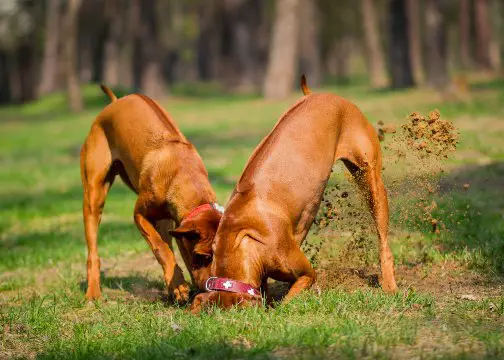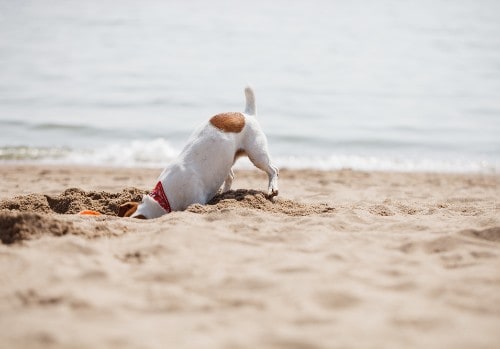Digging comes as naturally to a dog as breathing or eating. You could say our pups were made to do it… but that doesn’t make it any easier to deal with when it becomes destructive!
In no time at all, your dog can make your yard look more like a cratered moon than an earthly lawn. Your lovingly-tended vegetable garden can transform into a scene of produce slaughter.
And let’s not get started on what happens when your dog puts his digging talents to use on your neighbor’s property!
Training your dog to stop digging is an important part of canine ownership. Here are a few easy tips to jump-start your digging deterrence and return your yard to its former hole-free glory!
Provide Entertainment

When there’s nothing to do and nobody to hang out with, your dog will do just about anything to stimulate his senses and occupy his mind.
And if he has access to your yard, that “anything” could very well be digging.
Digging helps your dog expend physical energy, focus on a task, and enjoy the element of surprise — who knows what’s buried beneath the soil? It’s an easy way for him to pass the time until you’re ready to play with him or take him on a walk.
If you notice that your dog mainly digs when he’s alone or being ignored, chances are that his behavior is due to boredom. Presenting him with more attractive activities will help put a stop to his destructive digging.
And if your dog is left at home alone for extended periods, consider hiring a dog walker to come by and provide some exercise and attention. A doggy-daycare could also be a good option if your pup plays nicely with other dogs.
Control Pests
Groundhogs, rats, gophers, rabbits… wild animals are a source of both fascination and frustration for your dog. And if they’ve chosen your yard to hole up in, they could be the source of your dog’s unwanted digging.
Burrowing animals, like gophers, are particularly likely to prompt your dog to dig. Your dog can sniff them out even when they’re deep in their underground lairs — and once he’s locked onto the scent, he can’t stop himself from digging in.
But even above-ground dwellers like squirrels and chipmunks leave scent trails as they scamper across your yard. A particularly pungent patch could cause your dog’s digging instinct to kick in.
Controlling these nuisance animals will save your lawn from further damage, whether they or your dog causes it. Humane traps can be used to capture and relocate groundhogs and similar animals; for squirrels and other tricky characters, try an ultrasonic deterrent device.
Cool It Down

On hot days, any relief from the blazing heat is welcome. Shade, sprinklers, and pools are great ways for your dog to keep cool, but he may try to take matters into his own paws by digging himself a hole.
The ground is the coolest place to be when it’s hot: insulated by grass and layers of soil, dirt can be as much as 40 degrees cooler than the air! By digging a hole and rolling around in it, your dog can prevent himself from overheating and get a much-needed break from the oppressive warmth.
If sunny days seem to trigger your dog’s digging drive, provide him with another way to cool off. A plastic kiddy pool filled with cool water or the gentle spray of a sprinkler should prove irresistible!
And on truly sweltering days, when temperatures rise above 102 degrees (a dog’s normal body temperature), keeping your pup inside is best. At such high temperatures, your dog’s body can’t cool itself down, greatly increasing the risk of heat-stroke and other health complications.
Designate a Digging Zone
Some dogs just love to dig and will do it even when there’s no reason to. For these dogs, having a designated digging area is key to their well-being.
A doggy sandbox (or, more accurately, dirbox) is simply a large container or pit filled with dirt that your dog is allowed to dig in. Just fill it up and bury a few toys or chews, then bring your dog over and let him at it!
At first, you’ll need to monitor him and actively encourage him to use the digging zone. If you notice him digging in your main yard, redirect his attention to the dirtbox instead.
Over time, he’ll develop a habit of digging in the appropriate spot, saving your lawn and satisfying his innate need to dig.
